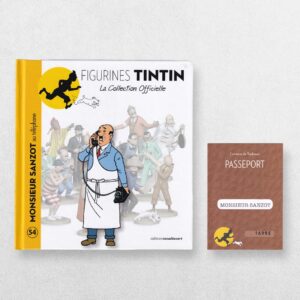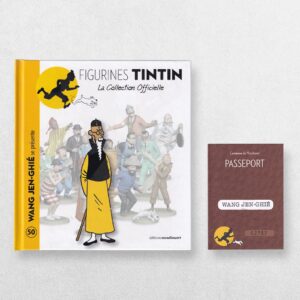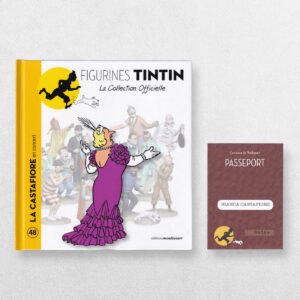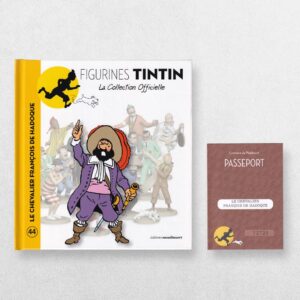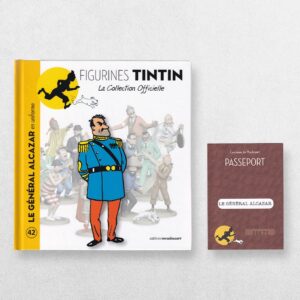Thomson As A Bather – Figurines Tintin La Collection Officielle – 55 – Dupont En Baigneur
Hergé & Editions Moulinsart
£65.00
Availability: In stock
Product Description
Thomson As A Bather – Figurines Tintin La Collection Officielle – 55 – Dupont En Baigneur
Author: Hergé & Editions Moulinsart
Price: £65.00
Publisher: Editions Moulinsart
Publication date: 2013
Format: Original pictorial boards with passport and figurine
Condition: In near fine condition
Illustrations: Illustrated throughout
Description:
Original pictorial boards. Includes passport loosely inserted. Text in French. Includes the accompanying figurine. One from the collection of 111 books and figurines. Very slight wear. In very near fine, clean condition overall.
Thomson As A Bather: A Short Biography
Thomson (known as Dupont in the original French) is one of the two nearly identical detectives — the other being Thompson (Dupond) — who serve as comic foils throughout The Adventures of Tintin. Distinguished only by the shape of their moustaches (Thomson’s ends are straight, Thompson’s curled), the pair appear in most Tintin stories, bringing a blend of well-meaning incompetence, slapstick humour, and unexpected loyalty.
While they are often seen as bumbling and absurd, Hergé infused them with charm and moral decency, making them essential to the series’ warmth and human balance.
Character Overview
Thomson and Thompson are detectives with the Sûreté (a fictionalised form of the French or Belgian police), and though they claim professionalism, their cases usually descend into confusion and comic mishap.
Thomson — the one without the curved moustache — is outwardly identical to his partner in appearance, voice, and behaviour. The two finish each other’s sentences, repeat each other’s mistakes, and fall victim to the same misunderstandings.
Their English names, Thomson and Thompson, were chosen to reflect this similarity: nearly the same, yet subtly different. Hergé used the distinction to highlight the futility of bureaucracy and the comedy of human error.
Origins and Creation
Hergé modelled Thomson and Thompson on real-life figures — including his own father and uncle, who were identical twins and frequently dressed alike. Their French names (Dupont and Dupond) are deliberately chosen homophones, emphasising their interchangeable nature.
The pair first appeared in Cigars of the Pharaoh (1934), and their comic potential was immediately clear. They became recurring characters in nearly every Tintin adventure that followed, appearing in all but Tintin in the Land of the Soviets and Tintin in Tibet.
Personality and Traits
Thomson embodies the same essential qualities as his partner:
- Well-meaning but inept: He is unfailingly polite and dutiful, yet hopelessly clumsy in both reasoning and movement.
- Pompous yet good-hearted: His exaggerated sense of professionalism contrasts with his constant confusion.
- Courageous in spite of himself: Though fearful and foolish, he faces danger when duty calls.
- Linguistically comic: His speech is filled with malapropisms and tautologies (“To be precise, not to put too fine a point on it, it’s precisely that!”).
Thomson’s charm lies in his human frailty. He blunders and misinterprets but remains loyal, kind, and honest.
Role in the Tintin Universe
Thomson (and Thompson) serve several important narrative and symbolic roles in Hergé’s work:
- Comic Relief:
Their slapstick antics — from disguises gone wrong to linguistic confusion — provide humour that balances the tension of Tintin’s adventures. - Moral Counterpoint:
Though foolish, the detectives are fundamentally decent. Their respect for justice and truth, however clumsy, mirrors Tintin’s moral code in a gentler, more human form. - Satire of Authority:
Hergé gently mocks bureaucracy and institutional incompetence through the pair’s endless blunders. They represent the absurdities of officialdom — always confident, never correct. - Everyman Figures:
The detectives bring readers back to ordinary human experience. Where Tintin is exceptional, Thomson and Thompson are comfortingly average.
Notable Appearances
- Cigars of the Pharaoh (1934): Their debut, in which they mistakenly arrest Tintin before realising he is innocent.
- The Blue Lotus (1936): They follow Tintin to Shanghai, disguising themselves (badly) as Chinese. Their clumsiness provides humour amid the serious political plot.
- The Black Island (1938): Their detective work again trails behind Tintin’s efficiency.
- The Secret of the Unicorn (1943): They play a key supporting role, aiding Tintin and Captain Haddock in the hunt for the treasure of Sir Francis Haddock.
- Land of Black Gold (1950): Their prolonged disguise as Arabs and ensuing confusion about local customs is pure farce, typical of Hergé’s middle-period humour.
- Destination Moon and Explorers on the Moon (1953–54): They accompany Tintin on the lunar expedition — as ill-suited as ever to scientific work — and provide some of the most beloved comic scenes in the series.
Visual and Comic Characteristics
Hergé’s clean-line style lends itself perfectly to the twins’ physical comedy: synchronised gestures, mirrored falls, and identical facial expressions create visual rhythm and symmetry. The contrast between their impeccable suits and their clumsy behaviour amplifies the absurdity.
Their frequent use of canes and bowler hats — symbols of European respectability — also heightens the irony: figures of order undone by their own confusion.
Symbolism
Thomson represents the human face of folly — a symbol of good intentions defeated by limitation. Together with Thompson, he embodies the comedy of civilisation itself: well-dressed, polite, and hopelessly muddled.
Their mistakes and misunderstandings are never malicious; they reflect Hergé’s gentle view of humanity — imperfect, well-intentioned, and often ridiculous.
In this way, they provide a counterpoint to Tintin’s perfection. Where Tintin is idealised and precise, Thomson and Thompson are gloriously flawed.
Relationship with Tintin
Tintin treats Thomson and Thompson with consistent patience and respect, even when their errors endanger him. They, in turn, admire Tintin deeply and see him as a model of virtue and competence.
Their relationship adds emotional warmth to the series — a mixture of exasperation, affection, and mutual loyalty.
Legacy
Thomson (and Thompson) have become cultural icons, representing comic misunderstanding and bureaucratic muddle in popular imagination. Their bowler hats and identical moustaches are instantly recognisable, even to those unfamiliar with Tintin’s adventures.
They have appeared in every major adaptation of the series — animated films, television, and Steven Spielberg’s 2011 feature The Adventures of Tintin: The Secret of the Unicorn — where their clumsiness continues to delight new generations.
Critics often note that Hergé’s affection for the pair is palpable: they are never cruelly ridiculed, only lovingly teased.
Summary
- Name: Thomson (French: Dupont)
- Occupation: Detective with the Sûreté
- Distinguishing feature: Straight-ended moustache (vs. Thompson’s curled one)
- First appearance: Cigars of the Pharaoh (1934)
- Traits: Polite, bumbling, loyal, pompous, comically inept
- Symbolism: Represents the humanity of imperfection; satire of bureaucracy; moral decency through folly
- Partnership: With his twin-like colleague, Thompson (Dupond)
- Catchphrases: Tautological remarks such as “To be precise…” or “I would say, not to put too fine a point on it…”
Conclusion
Thomson, alongside his inseparable partner Thompson, stands as one of Hergé’s greatest comic creations — a perfect blend of parody and affection. Behind the farce lies warmth: a belief in human goodness despite absurdity.
Their presence transforms The Adventures of Tintin from pure adventure into comedy of character — a world where even the clumsiest detective can, in his own way, serve the cause of justice.
Why Buy from Us?
At Hornseys, we are committed to offering items that meet the highest standards of quality and authenticity. Our collection of objects and rare books are carefully curated to ensure each edition is a valuable piece of bibliographical history. Here’s what sets us apart:
- Authenticity and Provenance: Each item is meticulously researched and verified for authenticity and collation.
- Expert Curation: Our selection process focuses on significance, condition, and rarity, resulting in a collection that is both diverse and distinguished.
- Customer Satisfaction: We aim to provide an exceptional customer experience, from detailed descriptions to secure and prompt delivery of your purchase.
- Returns Policy: We offer an unconditional guarantee on every item. If you wish to return an item, it may be sent back to us within fourteen days of receipt. Please notify us in advance if you wish to do so. The item must be returned in the same condition as it was sent for a full refund.
Cataloguer: Daniel Hornsey
Daniel Hornsey has specialised in fine and rare books, ephemera, and collectors’ editions for over thirty years. As a long-standing member of the antiquarian book trade, he has advised private collectors, curated catalogues, and sourced works for leading dealers, libraries and institutions across the world.
Hornseys’ exhibit regularly at book and map fairs in London and throughout the UK and are members of the Provincial Booksellers Fairs Association, the PBFA.
His fascination with Hergé’s work — especially ‘The Adventures of Tintin’ — began in childhood. Daniel recalls reading Tintin in original European editions and quickly recognising that these were not merely children’s books, but finely illustrated narratives crafted with artistic depth and wit.
As noted by the Musée Hergé in Louvain-la-Neuve, Hergé’s ‘ligne claire’ style has influenced generations of European comic artists and his original drawings and paintings command very high prices with his painting of ‘The Blue Lotus’ jar fetching £2.8m at auction in 2021.
By presenting these works through Hornseys’, he hopes to contribute to the continued appreciation of one of the 20th century’s most influential illustrators, helping new generations discover the artistry and legacy of Hergé.
Related products
When We Were Very Young – Winnie The Pooh – Now We Are Six – The House At Pooh Corner – The Collectors’ Facsimile Edition – Four Volumes In Slipcase
£85.00Milne, A. A. & Shepard, Ernest H
You may also like…
Mr Cutts The Butcher On The Telephone – Figurines Tintin La Collection Officielle – 54 – Monsieur Sanzot Au Téléphone
£65.00Hergé & Editions Moulinsart
Mr Wang Introduces Himself – Figurines Tintin La Collection Officielle – 50 – Wang Jen-Ghie Se Présente
£60.00Hergé & Editions Moulinsart
Castafiore In Concert – Figurines Tintin La Collection Officielle – 48 – La Castafiore En Concert
£45.00Hergé & Editions Moulinsart
Sir Francis Haddock – Figurines Tintin La Collection Officielle – 44 – Le Chevalier François De Hadoque
£95.00Hergé & Editions Moulinsart
General Alcazar In Uniform – Figurines Tintin La Collection Officielle – 42 – Le Général Alcazar En Uniforme
£45.00Hergé & Editions Moulinsart
Colonel Sponsz Upset – Figurines Tintin La Collection Officielle – 37 – Le Colonel Sponsz Contrarié
£55.00Hergé & Editions Moulinsart
Monsieur Boullu The Stonemason – Figurines Tintin La Collection Officielle – 35 – Monsieur Boullu Le Marbrier
£40.00Hergé & Editions Moulinsart
Haddock Alpinist – Figurines Tintin La Collection Officielle – 34 – Haddock En Alpiniste
£45.00Hergé & Editions Moulinsart
Calculus The Gardener – Figurines Tintin La Collection Officielle – 28 – Tournesol En Jardinier
£35.00Hergé & Editions Moulinsart
Haddock As Hadoque – Figurines Tintin La Collection Officielle – 24 – Haddock En Hadoque
£45.00Hergé & Editions Moulinsart
Ridgewell The Explorer – Figurines Tintin La Collection Officielle – 23 – Ridgewell L’Explorateur
£45.00Hergé & Editions Moulinsart
Tintin In Kilt – Figurines Tintin La Collection Officielle – 22 – Tintin En Kilt
£65.00Hergé & Editions Moulinsart
King Muskar Puts On His Gloves – Figurines Tintin La Collection Officielle – 20 – Le Roi Muskar Enfile Ses Gants
£45.00Hergé & Editions Moulinsart
Snowy Stuck In The Crab Tin – Figurines Tintin La Collection Officielle – 19 – Milou Coincé Dans La Boîte De Crabe
£45.00Hergé & Editions Moulinsart
Nestor With The Tray – Figurines Tintin La Collection Officielle – 18 – Nestor Au Plateau
£45.00Hergé & Editions Moulinsart
Chang Points Out Hou Kou – Figurines Tintin La Collection Officielle – 8 – Tchang Indique Hou Kou
£35.00Hergé & Editions Moulinsart
Tintin In A Lunar Spacesuit – Figurines Tintin La Collection Officielle – 7 – Tintin En Scaphandre Lunaire
£55.00Hergé & Editions Moulinsart
Snowy Carries His Bone – Figurines Tintin La Collection Officielle – 6 – Milou Promène Son Os
£40.00Hergé & Editions Moulinsart
Castafiore With The Parrot – Figurines Tintin La Collection Officielle – 5 – La Castafiore Au Perroquet
£75.00Hergé & Editions Moulinsart
Thomson Looking Awkward – Figurines Tintin La Collection Officielle – 4 – Dupond Engoncé
£40.00Hergé & Editions Moulinsart
Professor Calculus With A Spade – Figurines Tintin La Collection Officielle – 3 – Tournesol A La Bêche
£40.00Hergé & Editions Moulinsart
Haddock Doubtful – Figurines Tintin La Collection Officielle – 2 – Haddock Dubitatif
£40.00Hergé & Editions Moulinsart
Tintin In Trenchcoat – Figurines Tintin La Collection Officielle – 1 – Tintin En Trench-Coat
£75.00Hergé & Editions Moulinsart







